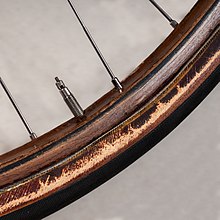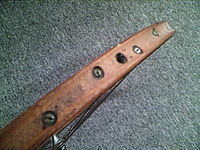Tubular tyre


A tubular tyre, referred to as a tub in Britain,[1] a sew-up in the US, a single in Australia, or just a tubular is a bicycle tyre that is stitched closed around the inner tube to form a torus. The combination is then glued (sometimes with two-sided tape) onto a specially designed rim, referred to as a "sprint rim" in Britain,[2][3] and just a "tubular rim" in the US,[4] of a bicycle wheel.
Tubular tyres require more labour to repair a puncture than clincher tyres (wired–on in Britain). The tyre must be removed from the rim, opened up, patched, sewn back up, then finally glued back to the rim. Clinchers have largely replaced tubulars for amateur racing (although they have see a revival due to the carbon rim being better suited to tubular design), but tubulars are still commonly used for indoor track racing (where the closed track makes punctures from road debris less commonplace), professional road racing, road time trials, and cyclo-cross racing.
The resulting combination was either slightly lighter or stronger than more common clincher tyres [5] until the clincher tyres and rims technology caught up in recent years. Taken as a whole the total weight of a tubular rim and tyre is always lighter than its clincher equivalent. However, for all non-racing purposes the lightness advantage is somewhat offset by the need to carry at least one entire spare tubular tyre (only a patch kit or inner tube are needed if using clincher tyres). Yet the extra weight—and more importantly, rotational inertia—is off the wheel, which therefore accelerates more easily. Advances in tire sealant have made carrying an extra tire a bit outdated.
Other advantages of this system include a decreased chance of pinch flats,[1] it can be made to operate in a wider range of tyre pressures (from 25 to 200 psi). Furthermore, when a tubular goes flat at high speed there is a safety margin because it is less likely to roll off the rim if it is properly glued on.
Tubular tyres are fitted with Presta valves.[1]
A tubeless tubular, with an integrated airtight liner instead of a separate inner tube, has been introduced.[6]
Gallery
-
Rims for tubular tyres, referred to as "sprint rims" in Britain
-
Detail of wooden rim for tubular tyres
-
André Leducq and Georges Speicher in the 1933 Tour de France carrying spare tubular tyres on their shoulders
References
- ^ a b c Sheldon Brown. "Sheldon Brown's Glossary Tp-Z: Tub". Retrieved 2016-09-28.
- ^ St. Pierre, Roger (1978). The Book of the Bicycle. Tribune Books Press. pp. 24–26. ISBN 0-85674-016-0.
- ^ Sheldon Brown. "Sheldon Brown's Bicycle Glossary Sp-Ss: Sprint". Retrieved 2010-03-22.
British: a rim designed for tubular tires.
- ^ "Tubular Tire Gluing". Park Tools. Retrieved 2010-03-24.
The tubular is then glued to a special rim, called a tubular rim.
- ^ Arthur S. Waltho (1964). Guide to Tubular Tyres, Including Sprint Rims.
- ^ "Bike Europe: Tufo Tubeless Road Racing Tyres". 2009-01-15. Retrieved 2009-02-02.



